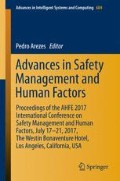Abstract
According to current prognosis, an excess of age is expected for the working population. Therefore, dealing with age-related impairments of sensory functions such as hearing impairment, is a central issue. Age and age-related impairments might influence employees’ performance especially in exhausting and stressful working situations. Furthermore, reduced hearing capacity bears a serious safety risk. To improve the communication especially regarding safety, communication friendly working procedures can be implemented.
A field study with white-collar workers was conducted. Audiometric data results showed that 57.9% of the participants had a slight hearing loss, 34.2% showed a mild to moderate hearing impairment. Most of the participants reported that they do strongly rely on communication at their workplace. Based on interviews and workshops difficult hearing situations were identified and procedures to prevent misunderstandings were derived. Furthermore, examples of procedures to improve the hearing environment are presented.
Access this chapter
Tax calculation will be finalised at checkout
Purchases are for personal use only
References
Heger, D., Holube, I.: Wie viele Menschen sind Schwerhörig? [How many people are hearing-impaired?] Zeitschrift für Audiologie, vol. 49, pp. 61–70 (2010)
Mathers, C., Smith, A., Concha, M.: Global burden of hearing loss in the year 2000. Global Burdon of Disease, pp. 1–30. World Health Organization, Geneva (2000)
Hasson, D., Theorell, T., Westerlund, H., Canlon, B.: Prevalence and characteristics of hearing problems in a working and non-working Swedish population. J Epidemiol. Commun. Health. 64, 453–460 (2010)
National academy of an aging society: hearing loss: a growing problem that affects quality of life. challenges of the 21st century: chronic and disabling conditions, pp. 1–6, 2 December 1999
Beattie, R.C., Barr, T., Roup, C.: Normal and hearing-impaired word recognition scores for monosyllabic words in quiet and noise. Br. J. Audiol. 31, 153–164 (1997)
Morata, T.C., Themann, C.L., Randolph, R.F., Verbsky, B.L., Byrne, D.C., Reeves, E.R.: Working in noise with a hearing loss: perceptions from workers, supervisors, and hearing conservation program managers. Ear Hear. 26, 529–545 (2005)
Wagner, V., Kallus, K.W.: Aging working population: hearing impairment a growing challenge for the working environment. In: Zhou, J., Salvendy, G. (eds.) Human Aspects of IT for the Aged Population, Design for Everyday Life, Springer multi-volume set, ITAP 2015, Part II. LNCS, vol. 9194, pp. 354–364. Springer, Switzerland (2015)
McCoy, S.L., Tun, P.A., Cox, L.C., Colangelo, M., Stewart, R.A., Wingfield, A.: Hearing loss and perceptual effort: downstream effects on older adults’ memory for speech. Q. J. Exp. Psychol. Sect. A: Hum. Exp. Psychol. 58, 22–33 (2005)
Kahneman, D.: Attention and Effort. Prentice-Hall Inc., Englewood Cliffs (1973)
Rabbitt, P.M.A.: Channel-capacity, intelligibility and immediate memory. Q. J. Exp. Psychol. 20, 241–248 (1968)
Jansen, N.W.H., Kant, I.J., van den Brandt, P.: Need for recovery in the working population: description and associations with fatigue and psychological distress. Int. J. Behav. Med. 9, 322–340 (2002)
Kiss, P., De Meester, M., Braeckman, L.: Differences between younger and older workers in the need for recovery after work. Int. Arch. Occup. Environ. Health 81, 311–320 (2008)
Nachtegaal, J., Kuik, D.J., Anema, J.R., Goverts, S.T., Festen, J.M., Kramer, S.E.: Hearing status, need for recovery after work, and psychosocial work characteristics: results from an internet-based national survey on hearing. Int. J. Audiol. 48, 684–691 (2009)
Dantscher, S.: Erfahrungen und Richtlinien für Warnsignale am Arbeitsplatz [Experiences and guidelines for warning signals in the workplace]. Lärmbekämpfung 7, 40–43 (2012)
DIN EN ISO 7731:2008-12: Ergonomics - danger signals for public and work areas - auditory danger signals (ISO 7731:2003), German version EN ISO 7731:2008. Beuth, Berlin (2008)
Deutsche Gesellschaft für Unfallversicherung DGUV [German Legal Accident Insurance]: Leitfaden für Betriebsärzte zur Beschäftigung von Schwerhörigen und Gehörlosen in Lärmbereichen. Medienhaus. Plump, Rheinbreitbach (2011)
Deutscher Schwerhörigenverbund DSB [German Federation of Deaf Persons]: Büroräume für hörgeschädigte Mitarbeiter- Hinweise zur Ausstattung [Office rooms for hearing-impaired employees – Notes on equipment]. TAUBERT und RUHE GmbH Beratungsbüro für Akustik und Therm. Bauphysik, Halstenbek (2008)
Lin, F.R., Ferrucci, L., Metter, E.J., Yang, A., Zonderman, A.B., Resnick, S.M.: Hearing loss and cognition in the Baltimore longitudinal study of aging. Neuropsychology 25, 763–770 (2011)
Neijenhuis, K., Tschur, H., Snik, A.: The effect of mild hearing impairment on auditory processing tests. J. Am. Acad. Audiol. 15, 6–16 (2004)
Wagner, V., Rominger, W., Kallus, K.W.: The category subdivision scale of subjective hearing impairment – a screening instrument for reduced hearing capacity. J. Ergono. 7(3), 1–7 (2017)
Jiménez, P., Kallus, K.W.: Recovery-Stress Questionnaire for Work (RESTQ-Work). Pearson Assessment & Information GmbH, Frankfurt am Main (2016)
Schwarzer, R., Jerusalem, M.: Skalen zur Erfassung von Lehrer- und Schülermerkmalen (SWE). Dokumentation der psychometrischen Verfahren im Rahmen der Wissenschaftlichen Begleitung des Modellversuchs Selbstwirksame Schulen [Scales for recording teacher and student characteristics (SWE). Documentation of the psychometric procedures within the scope of the scientific support of the pilot project Self-effective schools]. Freie Universität Berlin, Berlin (1999)
Acknowledgments
This work was supported by the Oesterreichische Nationalbank (OeNB) Anniversary Fund (grant number 16793).
Author information
Authors and Affiliations
Corresponding author
Editor information
Editors and Affiliations
Rights and permissions
Copyright information
© 2018 Springer International Publishing AG
About this paper
Cite this paper
Wagner, V., Grossi, N.R., Wolfgang Kallus, K. (2018). Age-Related Impairments like Reduced Hearing Capacity – A Safety Issue for the Working World?. In: Arezes, P. (eds) Advances in Safety Management and Human Factors. AHFE 2017. Advances in Intelligent Systems and Computing, vol 604. Springer, Cham. https://doi.org/10.1007/978-3-319-60525-8_3
Download citation
DOI: https://doi.org/10.1007/978-3-319-60525-8_3
Published:
Publisher Name: Springer, Cham
Print ISBN: 978-3-319-60524-1
Online ISBN: 978-3-319-60525-8
eBook Packages: EngineeringEngineering (R0)

